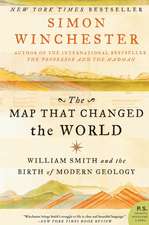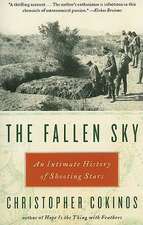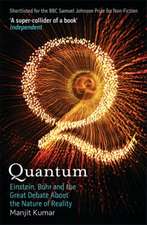The Chemical Element: A Historical Perspective: Greenwood Guides to Great Ideas in Science
Autor Andrew G. Edeen Limba Engleză Hardback – 29 iun 2006 – vârsta până la 17 ani
Preț: 305.00 lei
Preț vechi: 586.23 lei
-48% Nou
Puncte Express: 458
Preț estimativ în valută:
58.36€ • 60.81$ • 48.32£
58.36€ • 60.81$ • 48.32£
Carte tipărită la comandă
Livrare economică 03-17 aprilie
Preluare comenzi: 021 569.72.76
Specificații
ISBN-13: 9780313333040
ISBN-10: 0313333041
Pagini: 200
Dimensiuni: 178 x 254 x 19 mm
Greutate: 0.61 kg
Editura: Bloomsbury Publishing
Colecția Greenwood
Seria Greenwood Guides to Great Ideas in Science
Locul publicării:New York, United States
ISBN-10: 0313333041
Pagini: 200
Dimensiuni: 178 x 254 x 19 mm
Greutate: 0.61 kg
Editura: Bloomsbury Publishing
Colecția Greenwood
Seria Greenwood Guides to Great Ideas in Science
Locul publicării:New York, United States
Notă biografică
ANDREW EDE is an Assistant Professor in the Department of History and Classics at the University of Alberta. His most recent book is A History of Science in Society with Lesley Cormack.
Cuprins
1. Egyptian god Osiris.2. Geometric solids.3. Zeno's paradox.4. Aristotle's model of the Universe.5. Aristotle's Four Elements and Four Qualities.6. Yin Yang symbol.7. Alchemical symbols for materials and planets.8. The Alchemist by David Teniers the Younger, c. 1645.9. Robert Boyle's air pump.10. Joseph Priestley's pneumatic trough used for collecting gases.11. Lavoisier's constant pressure gas pump and reaction vessels.12. The calorimeter.13. Lavoisier's table of simple substances from Elements of Chemistry (1790).14. Dalton's elements and common "atoms." From John Dalton, New System of Chemical Philosophy (1808)15. Gustav Kirchhoff and Robert Bunsen's spectrocope, from "Chemical analysis by Observation of Spectra," (1860).16. Mendeleev's periodic table from Annalen der Chemie, (1872).17. Ceria and yttria isolation.18. Ultramicroscope.19. Fission.20. Fusion.
Recenzii
[A] delightful book written for an audience of scientists with an interest in the history of science. It is also suitable for nonscientists, as long as they have some level of interest in the fascinating details of how the chemical elements were first recognized as such and then, one by one, more were discovered. The alchemists and their obsession with transmutation, combined with Greek philosophy, on the one hand put a long dent in what would now be recognized as serious chemistry. On the other hand, the alchemists discovered a lot of useful synthetic techniques in their experiments and pioneered the development of useful chemical apparatus. The section on the periodic table and the short piece on the life of Mendeleev were certainly eye-openers for this reviewer. Scientists really do have life a lot easier these days..Highly recommended. General readers; lower-division undergraduates; faculty; professionals; two-year technical program students.
This excellent book on the historical perspective of the chemical element provides information not only on the history of the chemical elements, but also contains very useful appendices that should be of interest to chemistry students and their instructors at the high scholl through college levels..One of the nice features of the book is that every chapter contains interesting diagrams of reactions, tables, photographs, or sketches of equipment used by scientists over the ages..I highly recommend The Chemical Element as a resource for all high school chemistry teachers, and also to be included in secondary school libraries. It is the best book on this topic of which I am aware.
In this volume, Andrew Ede delivers more than the title suggests. The book is not only a history of the modern chemical elements, but a history of the very concept of matter being composed of a small number of irreducible, primary substances in varying combinations..This book provides a well-founded view of the concept's contributing origins..[t]he author has provided an interesting view of our developing understanding of matter.
This high-school level or general reader's guide to the study of matter at the theoretical and experimental level starts almost in the darkness of time with the Egyptian god Osiris and the ancient theory of matter. It then covers Greek matter theory including geometric solids, Zeno's paradox, Aristotle's model of the universe, including his four elements and four qualities, and discusses Chinese, Middle Eastern and Indian concepts, including the Yin-Yang symbol. It covers the alchemical symbols that sorted materials and planets and the contributions of alchemist David Teniers the Younger in the seventeenth century, the building of order through Boyle's air pump, Priestley's gas-collecting pneumatic trough, Lavoisier's constant pressure gas pump and reaction vessels, and Lavoisier's table of simple substances, followed by research on the atomic elements and the elements above 92.
This excellent book on the historical perspective of the chemical element provides information not only on the history of the chemical elements, but also contains very useful appendices that should be of interest to chemistry students and their instructors at the high scholl through college levels..One of the nice features of the book is that every chapter contains interesting diagrams of reactions, tables, photographs, or sketches of equipment used by scientists over the ages..I highly recommend The Chemical Element as a resource for all high school chemistry teachers, and also to be included in secondary school libraries. It is the best book on this topic of which I am aware.
In this volume, Andrew Ede delivers more than the title suggests. The book is not only a history of the modern chemical elements, but a history of the very concept of matter being composed of a small number of irreducible, primary substances in varying combinations..This book provides a well-founded view of the concept's contributing origins..[t]he author has provided an interesting view of our developing understanding of matter.
This high-school level or general reader's guide to the study of matter at the theoretical and experimental level starts almost in the darkness of time with the Egyptian god Osiris and the ancient theory of matter. It then covers Greek matter theory including geometric solids, Zeno's paradox, Aristotle's model of the universe, including his four elements and four qualities, and discusses Chinese, Middle Eastern and Indian concepts, including the Yin-Yang symbol. It covers the alchemical symbols that sorted materials and planets and the contributions of alchemist David Teniers the Younger in the seventeenth century, the building of order through Boyle's air pump, Priestley's gas-collecting pneumatic trough, Lavoisier's constant pressure gas pump and reaction vessels, and Lavoisier's table of simple substances, followed by research on the atomic elements and the elements above 92.






















